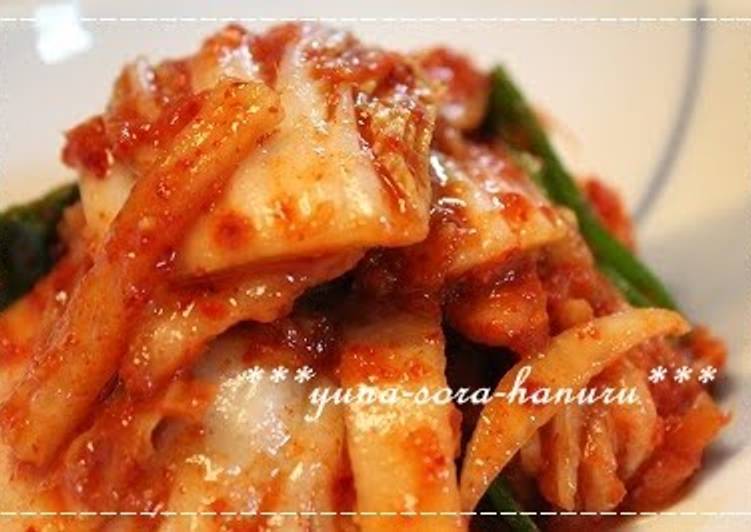Korean Kimchi from the Source. Great recipe for Korean Kimchi from the Source. Just when I was thinking "I want to make my own authentic kimchi!" I had a chance to learn how to do so from a Korean friend. Since then, I've been experimenting and researching the method (while receiving feedback) to come up with this recipe.
 Kimchi is a popular Korean dish. Kimchi, a traditional Korean delicacy is famous all over the world. The deep-set flavours in the dish set it apart, which apparently comes from the fermentation of. You can have Korean Kimchi from the Source using 15 ingredients and 16 steps. Here is how you cook that.
Kimchi is a popular Korean dish. Kimchi, a traditional Korean delicacy is famous all over the world. The deep-set flavours in the dish set it apart, which apparently comes from the fermentation of. You can have Korean Kimchi from the Source using 15 ingredients and 16 steps. Here is how you cook that.
Ingredients of Korean Kimchi from the Source
- Prepare of Chinese cabbage.
- Prepare of Coarse salt (pickling salt).
- Prepare of Coarsely ground chili pepper for kimchi.
- Prepare of Daikon radish.
- It's of to 4 stalks Green onion.
- You need of Ginger (grated).
- It's of Garlic (grated).
- You need of Onion (grated).
- You need of Apple (grated).
- Prepare of to 60 grams Salt cured ami ebi (small shrimp).
- It's of to 3 tablespoons Sardine extract (or fish sauce).
- Prepare of Sugar.
- Prepare of Salt.
- You need of Cooked rice.
- You need of to 80 ml Water.
By that time, families had long used preservation methods to keep a constant food supply for their families during the long, harsh winters. C., families turned to fermentation to preserve it. Over the last decade or so, Korean kimchi has gained a global recognition as a healthy probiotic food. Kimchi is a good source of useful lactic acid bacteria, has excellent anti-oxidation and anti-cancer effects, and helps prevent aging.
Korean Kimchi from the Source step by step
- Wash the Chinese cabbage, make cuts in the stem end and rip into half with your hands. Rip into half again to end up with 4 quarters..
- Make a high concentrate salt water in a large tub or bowl, and completely immerse the Chinese cabbage in it. Leave to soak so that the salt water penetrates to the core..
- When the leaves have become wilted, take the cabbage out and drain it off. Peeling back the leaves one by one, sprinkle in some salt, concentrating on the cores..
- Line the salted cabbage quarters in a pickling tub, add a weight and leave to pickle for 1/2 to 1 whole day or so. Turn it over occasionally so that it cures evenly..
- When the salt-pickled cabbage is done, rinse it well under running water. It should taste a bit salty..
- Put the cabbage on a sieve or colander and leave to drain and dry for 3 to 4 hours..
- When the salted cabbage is done, make the yangnyeom (kimchi base). Prepare each ingredient..
- Cut the daikon radish into 3 to 4 mm wide sticks. Cut the green onion into 4 cm long pieces. Grate the ginger, garlic, onion and apple..
- In Step 8, chop up the ginger and garlic and then purée it in the food processor..
- Put the rice and water in a food processor, and process until it forms a gluey paste. Adjust the amount of water depending on the consistency of the rice..
- From this point on, be sure to work with rubber gloves!! Ideally use ones that have long sleeves. Otherwise, regular rubber gloves are fine..
- Put all the ingredients in a bowl (leave out the salted cabbage out) and mix together well with your hands..
- When it looks like this it's all good (This is the yangnyeom.).
- Peel off the dried salted Chinese cabbage leaves, and spread each one with a little yangnyeom. Take special care to put plenty of yangnyeom on the cores..
- Wrap the cabbage leaves around each other with the core in the center, and it's done! Put into a sealed ziplock bag or similar, and put the bag into a sealed container and store in the refrigerator. Take out however much you'd like to enjoy each time..
- If you want to easily make a small amount, mix salted and dried Chinese cabbage that's been cut up into easy to eat pieces with yangnyeom. This is even easier..
This kimchi recipe is made with baechu (배추), known as napa cabbage, hence the name baechu kimchi. Korean sea salt is known for superior quality and high mineral content, which helps prevent the cabbages from softening quickly, while improving the taste of kimchi. It seems like kimchi recipes take so much salt, but a lot of it is washed off once the cabbages are properly salted. Kimchi organic acid is an essential human body's energy source, helps promote physical fitness and promotes digestion Weight loss food The variety of vegetables in kimchi provides low-calorie content, abundant dietary fiber which helps to control weight The pots are used to hold kimchi, soy bean paste, red pepper paste, and other foods that require air to ferment, which the clay — made from Korean rain water, plants, and mountain soil — provides. Kimchi (김치) is the accepted word in both North and South Korean standard languages.
Comments
Post a Comment